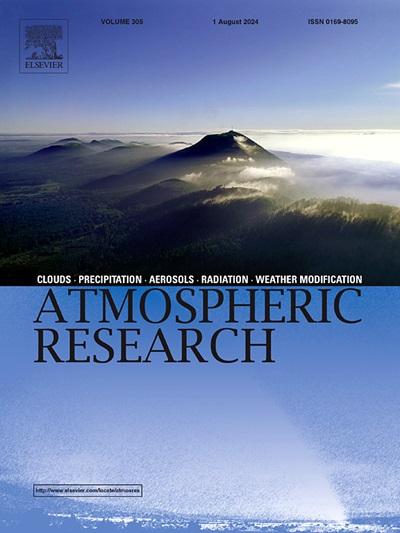The influence of corona sheath conductivity distribution on the transmission characteristics of return-stroke currents
IF 4.5
2区 地球科学
Q1 METEOROLOGY & ATMOSPHERIC SCIENCES
引用次数: 0
Abstract
The study on transmission characteristics of lightning return-stroke currents along the channel is of great significance for deeply understanding the microphysical mechanisms of lightning discharge processes, improving theoretical models, and optimizing lightning protection systems. Based on the spectra obtained from three lightning processes and the waveforms of ground electric field changes caused by the lightning, the characteristic parameters such as channel temperature, linear charge density, and radius are calculated. Combined with the electrodynamics model of lightning, the propagation process of electromagnetic waves in the lightning channel and the surrounding corona sheath is simulated, and the dispersion curves, as well as the intensity changes of radial and axial electric fields are obtained under two conditions: with and without considering the electrical conductivity in the corona sheath. The impact of the actual electrical conductivity distribution in the corona sheath on the transmission characteristic of electromagnetic waves is analyzed for the first time. On this basis, the transmission law of current along the channel height at different moments for the three return-strokes is simulated. The results show that compared with the case that only the electrical conductivity of the current-carrying core channel is considered, the radial distribution of electrical conductivity in the outer corona sheath will slow down the decay rate of current transmission along the channel. The larger the radius of the high electrical conductivity channel, the smaller the decay rate of the return-stroke current along the channel. In the early stage of the return-stroke, the current intensity decays rapidly along the channel height, decaying in an exponential form. As time goes on, the current decay slows down and gradually transitions to a linear decay or a uniform distribution form. It further confirms that the decay of the return-stroke current along the channel height is mainly manifested in the early stage of the return-stroke. The radius of the current-carrying channel and the distribution of conductivity in the corona sheath are key factors affecting the transmission decay of current along the channel.
求助全文
约1分钟内获得全文
求助全文
来源期刊

Atmospheric Research
地学-气象与大气科学
CiteScore
9.40
自引率
10.90%
发文量
460
审稿时长
47 days
期刊介绍:
The journal publishes scientific papers (research papers, review articles, letters and notes) dealing with the part of the atmosphere where meteorological events occur. Attention is given to all processes extending from the earth surface to the tropopause, but special emphasis continues to be devoted to the physics of clouds, mesoscale meteorology and air pollution, i.e. atmospheric aerosols; microphysical processes; cloud dynamics and thermodynamics; numerical simulation, climatology, climate change and weather modification.
 求助内容:
求助内容: 应助结果提醒方式:
应助结果提醒方式:


